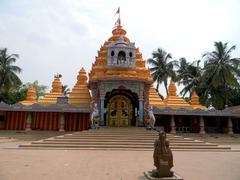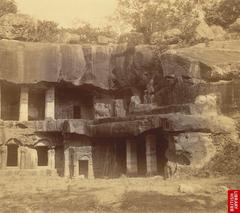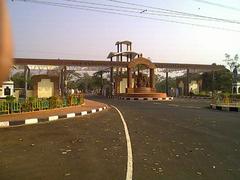Astasambhu Siva Temples Bhubaneswar: Visiting Hours, Tickets, and Historical Significance
Date: 04/07/2025
Introduction
The Astasambhu Siva Temples, a cluster of eight ancient shrines dedicated to Lord Shiva, are a pivotal part of Bhubaneswar’s spiritual and architectural heritage. Located in the city’s Old Town district, these temples exemplify early medieval Kalinga architecture and reflect the religious traditions that have shaped Odisha for centuries. With their serene ambiance, historical significance, and enduring rituals, the Astasambhu Siva Temples are essential for anyone seeking to understand the “Temple City of India.”
This guide covers the temples’ history, architectural features, visiting hours, ticket information, accessibility, travel tips, nearby attractions, festival highlights, conservation efforts, and frequently asked questions. Whether you are a heritage enthusiast, spiritual traveler, or curious visitor, use this resource to make your visit meaningful and memorable.
For additional insights, refer to resources such as Odisha Tourism, HelloTravel, TemplePurohit, and Orissa Guide.
Historical Background and Significance
Origins and Dynasty Patronage
The Astasambhu Siva Temples were constructed between the 9th and 10th centuries CE, during the reign of the Somavamsi dynasty. This period marked the zenith of Shaivism in Odisha, with the Somavamsis commissioning numerous shrines dedicated to Lord Shiva (Odisha Tourism). The cluster’s name combines “Ashta” (eight) and “Sambhu” (Shiva), each temple housing a distinct Shiva lingam and reflecting different manifestations of the deity.
Spiritual and Cultural Role
Beyond their architectural value, the temples remain centers of active worship. Rituals such as abhishekam (ritual bathing), daily pujas, and fire offerings are held, especially during festivals like Maha Shivaratri and the month of Shravan (July–August). The temples are privately managed by the Ratnakara Gargabatu family, ensuring the continuity of traditional practices (HelloTravel).
Mythological and Community Connections
Five of the shrines are aligned in a row, locally known as “Panchu Pandava,” symbolically linked to the Pandava brothers from the Mahabharata. The site is woven into the broader fabric of Bhubaneswar’s Shaivite traditions and is often included in pilgrimage circuits connecting Lingaraj, Mukteswar, and Uttaresvara temples.
Architectural Features
Kalinga Style and Structural Elements
The Astasambhu Siva Temples are notable examples of the Rekha Deul typology—characterized by a soaring, curvilinear spire (shikhara) above the sanctum. Built primarily from locally sourced sandstone using dry masonry techniques, each temple features:
- Square Vimana: Approximately 2.20–2.45 meters per side, with an east-facing entrance and a small frontal porch.
- Elevation: Height ranges from 4.15 to 5.72 meters, with three main divisions:
- Bada (Base): Four molded layers, including the pabhaga.
- Gandi (Spire): Smooth, unornamented central tower.
- Mastaka (Crowning Element): Includes the neck (beki), ribbed disc (amlaka), skullcap (khapuri), and finial pot (kalasa).
- Pancharatha Plan: Five vertical projections (pagas) on the exterior, creating rhythmic visual divisions (Wikipedia; TemplePurohit).
Ornamentation and Symbolism
The temples are austere, with minimal ornamentation. Doorjambs and niches are largely plain, but each central projection features lion motifs (udyota simhas) as symbolic guardians. The understated design prioritizes spiritual symbolism and structural clarity, representing an early phase of Kalinga temple art.
The Shiva Lingams
Each shrine houses a Shiva lingam crafted from precious stones in white, red, or black. The names of the lingams (such as Markandeswar and Nilakantheswara) reflect different aspects of Shiva. The stone colors change with the sunlight, adding to the mystical ambiance (Odikala Guide).
Visiting Hours, Tickets, and Accessibility
Timings and Entry
- Open Daily: 6:00 AM – 8:00/9:00 PM (timings may vary slightly depending on sources and festival days) (TemplePurohit).
- Entry Fee: Free for all visitors. Donations are welcomed but not required.
- Photography: Permitted in exteriors and courtyards. Photography inside sanctums is generally not allowed, especially during rituals.
Accessibility
- Location: Within the Uttaresvara Siva Temple precinct, about 2 km from Bhubaneswar city center.
- Transport: Easily accessible by taxi, auto-rickshaw, and public buses.
- By Air: Biju Patnaik International Airport is 4–7 km away.
- By Rail: Bhubaneswar Railway Station is 3–6 km away.
- By Bus: Baramunda Bus Station is the main terminal for city and regional buses.
- Mobility: Paved paths connect the shrines, but historic stone flooring and steps may present challenges for visitors with limited mobility. Wheelchair access is limited; prior arrangements are advised.
Facilities
- Restrooms: Available near major temples such as Lingaraj and Mukteswar.
- Drinking Water: Filtered water stations are present but carrying your own water is recommended.
- Shops: Vendors sell offerings and local snacks nearby.
Visitor Experience and Tips
Best Time to Visit
- Optimal Season: October to March, with pleasant weather and clear skies.
- Festivals: Maha Shivaratri and Shravan attract large crowds and offer vibrant celebrations, though expect heightened security and busy conditions.
- Avoid: Monsoon (June to September) due to heavy rainfall and summer (March–June) for high temperatures.
Dress Code and Etiquette
- Attire: Modest clothing that covers shoulders and knees. Remove footwear before entering temple premises.
- Behavior: Maintain silence, respect ongoing rituals, and follow instructions from temple staff. Non-Hindus may face restricted access to certain sanctums.
Guided Tours
- Licensed guides and audio tours are available at larger temples nearby. For deeper insights, consider joining a guided tour through a local operator or the Archaeological Survey of India (ASI).
Nearby Attractions and Integration with Bhubaneswar’s Heritage
The Astasambhu Siva Temples are part of Bhubaneswar’s renowned temple landscape. Don’t miss:
- Lingaraj Temple: The city’s largest and most revered temple.
- Mukteswar Temple: Celebrated for its elegant torana (gateway).
- Rajarani Temple: Famous for its unique architectural style.
- Bindusagar and Godavari Tanks: Sacred water bodies enhancing the spiritual ambiance.
- Odisha State Museum: For a broader historical context.
These sites are within a 1–2 km radius and can be combined for a comprehensive spiritual and cultural tour (Tripcrafters; WanderOn).
Conservation and Modern Relevance
Recognized as protected monuments, the Astasambhu temples are maintained through heritage conservation programs. Restoration efforts focus on structural stability and preserving their spiritual functions. The temples remain living heritage sites, with rituals and festivals reinforcing their role in Bhubaneswar’s contemporary religious life (Odisha Tourism).
Frequently Asked Questions (FAQs)
Q: What are the visiting hours?
A: Daily from 6:00 AM to 8:00 or 9:00 PM, depending on the specific temple and season.
Q: Is there an entry fee or ticket required?
A: No, entry is free. Donations are welcome.
Q: Can I take photographs inside the temples?
A: Photography is allowed in exteriors and courtyards, but generally not inside sanctums or during rituals.
Q: Are guided tours available?
A: Yes, through local operators or guides at temple entrances.
Q: How do I reach the temples from the airport or railway station?
A: Take a taxi or auto-rickshaw from Biju Patnaik International Airport (4–7 km) or Bhubaneswar Railway Station (3–6 km).
Q: Are the temples accessible for differently-abled visitors?
A: Accessibility is limited due to historic structures and uneven floors; prior arrangements are recommended.
Plan Your Visit
The Astasambhu Siva Temples invite visitors to immerse themselves in Odisha’s spiritual and architectural legacy. To enhance your experience:
- Visit during the cooler months.
- Consider a guided tour for richer context.
- Respect local customs and dress appropriately.
- Pair your visit with nearby landmarks for a holistic exploration of Bhubaneswar’s temple culture.
For updates, download the Audiala app, explore related articles, and follow us on social media.
Sources and Further Reading
- Astasambhu Siva Temples Bhubaneswar: History, Visiting Hours, Tickets & Travel Guide, Odisha Tourism
- Astasambhu Siva Temples in Bhubaneswar: A Complete Visitor’s Guide, HelloTravel
- Astasambhu Siva Temples Bhubaneswar: Visiting Hours, Tickets & Architectural Highlights, TemplePurohit
- Orissa Guide
- Odikala Guide
- Wikipedia: Astasambhu Siva Temples
- Tripcrafters Bhubaneswar Guide
- WanderOn Temples in Bhubaneswar
- LightUpTemples: Bhubaneswar Astasambhu Siva Temple
Related Articles
- Discover the Rajarani Temple’s unique architecture
- Guide to Odisha’s Sacred Tanks and Water Bodies








